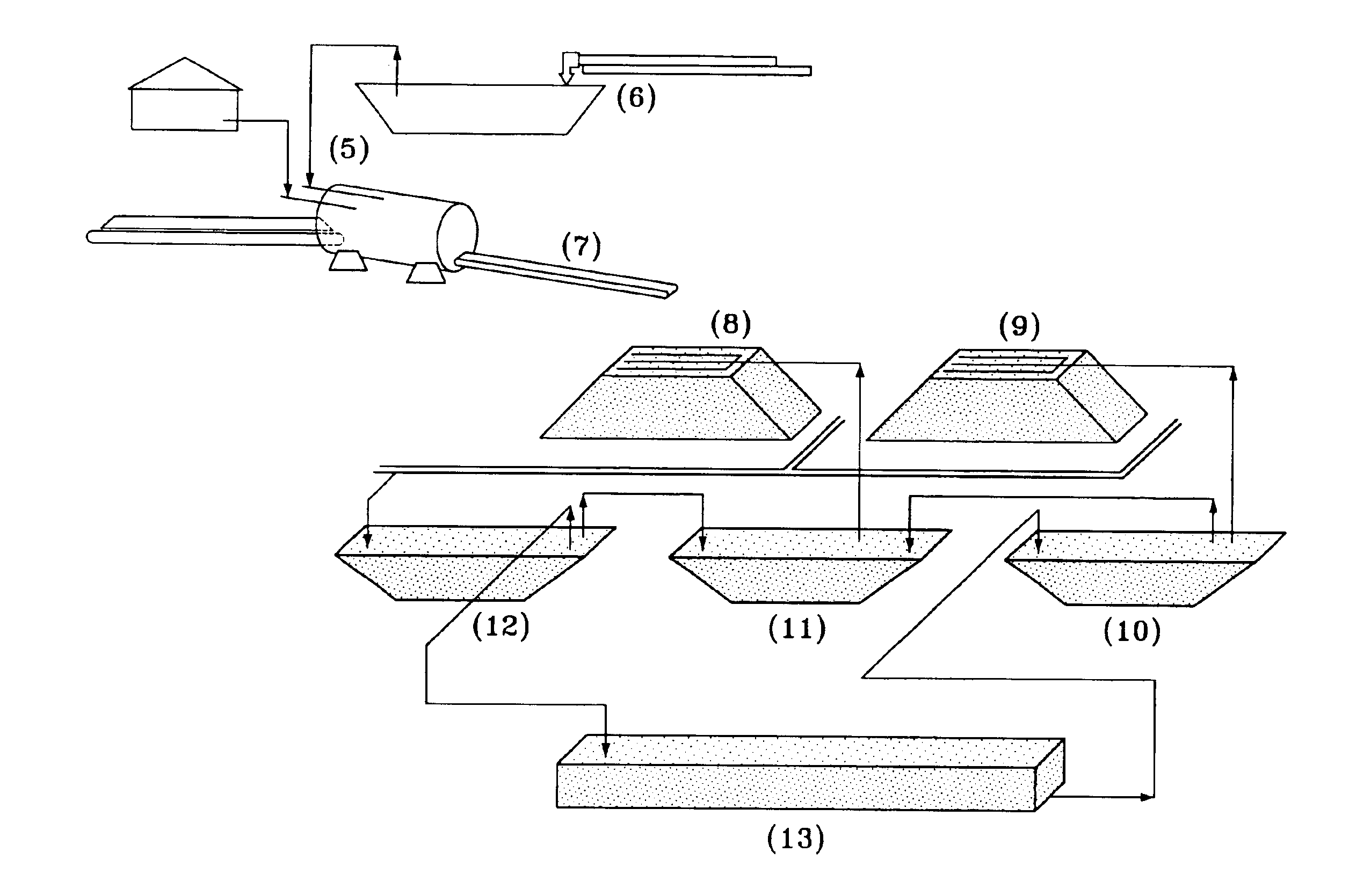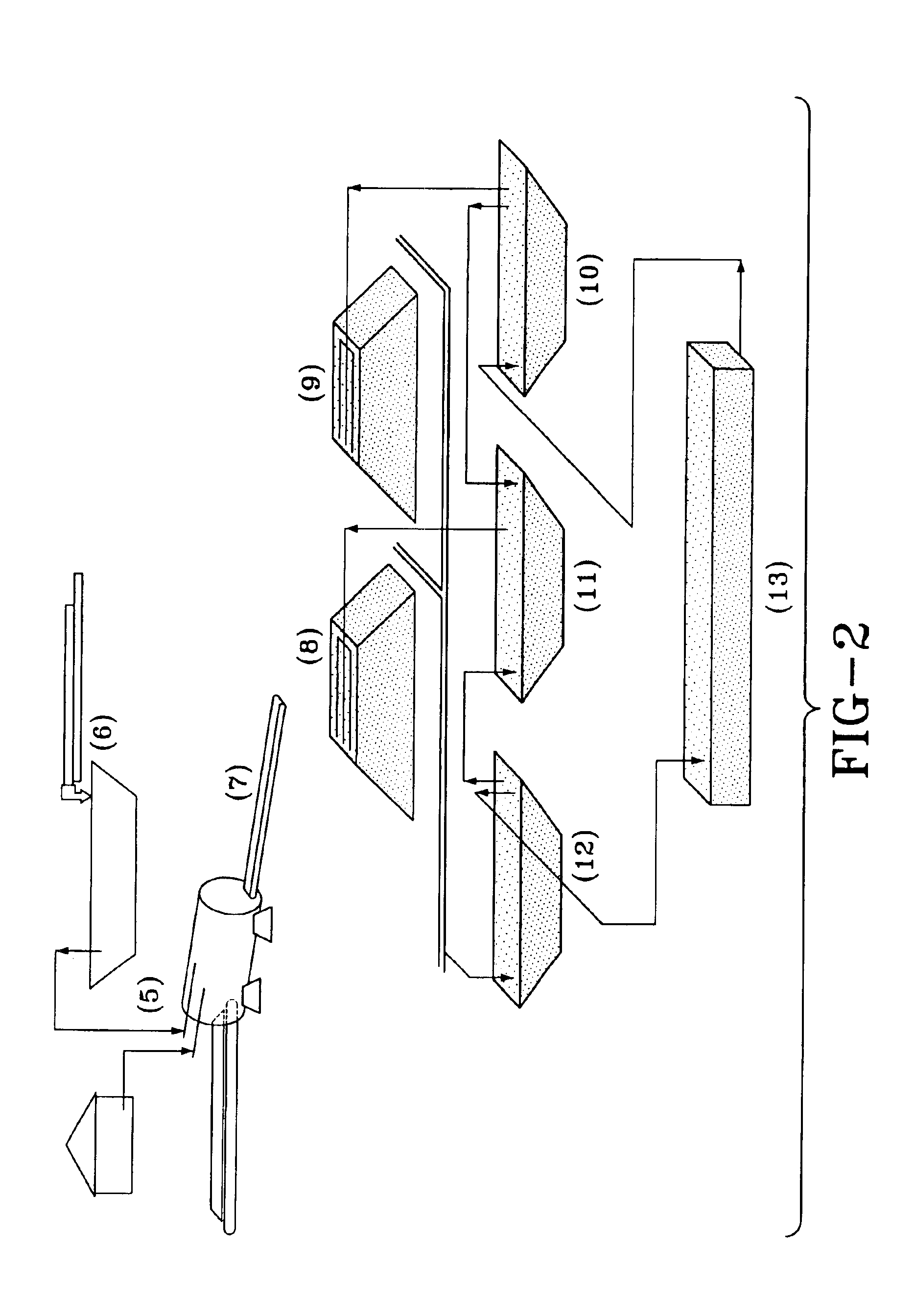Non-biochemical method to heap leach copper concentrates
a technology of agglutinate copper concentrate and agglutinate copper, which is applied in the direction of fluid removal, earthwork drilling and mining, and well accessories, etc. it can solve the problems of not being able being unable to meet the requirements of agglutinate, etc., to achieve simple and cheaper, long reaction time, and large equipmen
- Summary
- Abstract
- Description
- Claims
- Application Information
AI Technical Summary
Benefits of technology
Problems solved by technology
Method used
Image
Examples
example no.1
Example No. 1
[0100]In this example, two semi-industrial heaps, 1,000 tons each, were formed, mixing a low grade ore from the ore body Estefania of Minera Michilla, with the following chemical characteristics, was mixed: total Cu: 0.52%; soluble Cu: 0.30%, and an acid consumption per laboratory test of 90 Kg / ton, this ore was used as base material. It was mixed with a concentrate, in two different proportions, in a stockpile with 6.9%, and the other one with 10.1%. This concentrate had the following characteristics: total Cu=26.10%; soluble Cu=7.27%, and an acid consumption at the laboratory of 150 Kg / ton. According to the mineralogical analysis, the sulphide part of this concentrate is mainly composed of calcosine, around 85%, and the rest is composed of coveline, bornite, and in lower degree of chalcopyrite. The particles size distribution, with its respective copper grade, of the concentrate and the ore, were the following:
[0101]
CONCENTRATE PARTICLES SIZE DISTRIBUTION%%% CuT% CuS%...
example no.2
Example No. 2
[0110]To show that this process is also applicable to other copper species, not only those of the chalcocite type as seen in the previous example, other experience was realized with concentrate from the flotation of copper slag smelting. This new concentrate had the following global characteristics: Chemical composition: 31.28% of Total Cu, 3.30% of Soluble Cu; 23.4% of Total Fe, and 8.11%, of Soluble Fe, and a laboratory acid consumption of 9.0 Kg of acid per Kg of Soluble Cu. The particle size analysis gave the following values:
[0111]
MassMass% CuT% CuS% CuIMesh% %[%][%][%]65#1.011.0127.097.5219.57100#2.153.1631.444.3027.14200#12.4415.633.592.8630.73−200#84.40100.031.143.0128.13Total100.031.413.0628.35
[0112]The mineralogical analysis, on the other hand, recognized the presence of the following species: Chalcopyrite: 60%, Chalcocite 24.1%, Coveline: 1.6%, Bornite: 5.2% with some pyrite (6.7%) and pyrrhotite (<2%). It is also interesting to state that the X-Ray analysis ...
example no.3
Example No. 3
[0120]Finally, an example for the copper material more difficult to leach, corresponding to a concentrate mainly composed of chalcopyrite, is included. With this example, the process described hereby is proven to be worthy for all the types of copper sulphide concentrates.
[0121]The chalcopyrite concentrate used had the following characteristics: Global chemical composition: 45.36% of Total Cu, 2.80% of Soluble Cu; 16.5% of Total Fe, 0.8% of Soluble Fe, and a laboratory acid consumption of 16.0 Kg of acid per Kg of Soluble Cu.
[0122]The grain size analysis gave the following values:
[0123]
MassMass% CuT% CuS% CuIMesh%% Accu[%][%][%]65#0.000.00100#1.181.1836.062.8033.26200#15.1416.3240.151.8038.35−200#83.68100.046.911.6045.31Total100.045.761.6444.12
[0124]On the other hand, the mineralogical analysis showed the presence of the following species: Chalcopyrite: 65.2%, Digenite: 25.1%, Coveline: 7.7%, bornite: 2.0%, and some pyrite (2.6%). It is also interesting to stress the fa...
PUM
| Property | Measurement | Unit |
|---|---|---|
| weight fraction | aaaaa | aaaaa |
| density | aaaaa | aaaaa |
| diameter | aaaaa | aaaaa |
Abstract
Description
Claims
Application Information
 Login to View More
Login to View More - R&D
- Intellectual Property
- Life Sciences
- Materials
- Tech Scout
- Unparalleled Data Quality
- Higher Quality Content
- 60% Fewer Hallucinations
Browse by: Latest US Patents, China's latest patents, Technical Efficacy Thesaurus, Application Domain, Technology Topic, Popular Technical Reports.
© 2025 PatSnap. All rights reserved.Legal|Privacy policy|Modern Slavery Act Transparency Statement|Sitemap|About US| Contact US: help@patsnap.com



